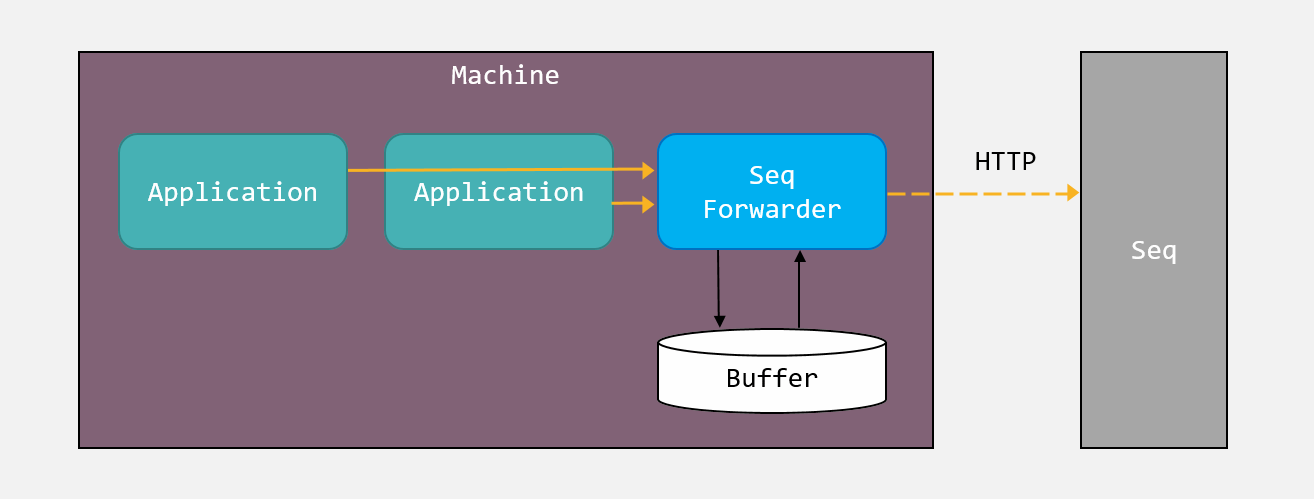Seq Forwarder Datalust Pty Ltd
winget install --id=Datalust.seqfwd -e Seq Forwarder is a client-side log collector that receives events over its local HTTP API and persists them to its own internal storage until a remote Seq server can be reached.
Seq Forwarder is a client-side log collector designed to reliably gather and forward log data to a remote Seq server. It operates by receiving events via its local HTTP API, storing them in internal storage until the target Seq server becomes available.
Key Features:
- Local HTTP API for log ingestion, compatible with standard Seq clients.
- Persistent storage of logs until successful forwarding to the target Seq server.
- Support for client-provided API keys or a configured API key for authentication.
- Configurable buffer size to manage local storage capacity.
- Cross-platform compatibility with installation options for Windows, macOS, and Linux.
- Installable as a Windows service for seamless operation.
Ideal for developers, DevOps teams, and organizations requiring reliable log collection and forwarding. Seq Forwarder ensures logs are captured consistently, even during temporary server unavailability, minimizing data loss and maintaining operational visibility. It can be installed via winget for convenient setup on supported platforms.
README
Seq Forwarder 


Seq Forwarder is a client-side log collector that receives events over its local HTTP API and persists them to its own internal storage until a remote Seq server can be reached.

Seq Forwarder listens on port 15341 by default. The HTTP ingestion API is identical to
the Seq one, so standard client libraries like Serilog.Sinks.Seq can write to
it directly.
Log.Logger = new LoggerConfiguration()
.WriteTo.Seq("http://localhost:15341")
.CreateLogger();
Log.Information("Hello, Seq Forwarder!");
Client applications can specify an API key when logging to Seq Forwarder. In this case the API key supplied by the client will be forwarded along to the target Seq server.
Alternatively, Seq Forwarder can be configured with an API key, and will use this to log to Seq when client applications do not specify one.
Getting started
First, download the release bundle for your platform, and extract it to a suitable location.
The instructions below use the seqfwd command-line. To learn about available commands, try seqfwd help.
On Windows
To set up Seq Forwarder as a Windows service, from an administrative PowerShell prompt in the Seq Forwarder directory, set the target Seq server URL and an optional API key:
./seqfwd config -k output.serverUrl --value="http://seq.example.com/"
./seqfwd config -k output.apiKey --value="1a2b3c4d5e6f"
./seqfwd config -k storage.bufferSizeBytes -v 1073741824
./seqfwd install
./seqfwd start
The default buffer size limit is 64 MB. In the example, this is increased to 1 GB.
To upgrade, stop the service, overwrite the forwarder release bundle, and restart the service.
On Windows, Seq Forwarder will used machine-scoped DPAPI to encrypt the default API key and any API keys supplied by clients.
On macOS or Linux
On Linux, you'll need liblmdb:
apt install liblmdb-dev
To run Seq Forwarder, configure the target Seq server URL, and optionally, an API key:
./seqfwd config -k output.serverUrl --value="http://seq.example.com/"
./seqfwd config -k output.apiKey --value="1a2b3c4d5e6f"
./seqfwd config -k storage.bufferSizeBytes -v 1073741824
./seqfwd run
Note that on macOS and Linux, the output API key and any API keys provided by clients will be stored in plain text.
The default buffer size cap is 64 MB. In the example, this is increased to 1 GB.
Development
Seq Forwarder is a .NET Core application that can be built using the .NET Core SDK on Windows, macOS, and Linux.
To debug, F5 will work, but on Windows you will need to either run the install command (see below) to create an HTTP namespace
reservation, or run as Administrator.
Troubleshooting
By default the "forwarder" logs will be stored under %PROGRAMDATA%\Seq\Logs. If the destination Seq server is not
available, an exception will be stored in these log files.
If you need to inspect the current configuration, it can be found at: %PROGRAMDATA%\Seq\Forwarder\SeqForwarder.json
Command line usage
> ./seqfwd help
Usage: seqfwd []
Available commands are:
bind-ssl Bind an installed SSL certificate to an HTTPS port served by Seq
Forwarder
config View and set fields in the SeqForwarder.json file; run with no
arguments to list all fields
dump Print the complete log buffer contents as JSON
help Show information about available commands
install Install the Seq Forwarder as a Windows service
restart Restart the Windows service
run Run the server interactively
start Start the Windows service
status Show the status of the Seq Forwarder service
stop Stop the Windows service
truncate Clear the log buffer contents
uninstall Uninstall the Windows service
version Print the current executable version
Note that the Windows HTTP and service-related commands (bind-ssl, install, restart, start, status, stop,
and uninstall) are only available on that platform.
SeqForwarder.json configuration example
The seqfwd config command reads and writes SeqForwarder.json:
{
"diagnostics": {
"internalLogPath": "C:\\ProgramData\\Seq\\Logs\\",
"internalLoggingLevel": "Information"
},
"output": {
"serverUrl": "http://localhost:5341",
"eventBodyLimitBytes": 262144,
"rawPayloadLimitBytes": 10485760,
"apiKey": null
},
"storage": {
"bufferSizeBytes": 67108864
},
"api": {
"listenUri": "http://localhost:15341"
}
}
On Windows, this file lives in C:\ProgramData\Seq\Forwarder.